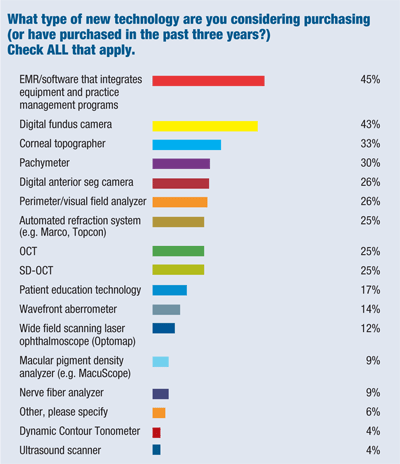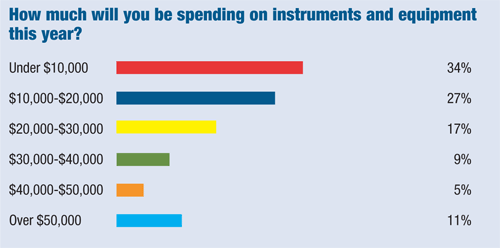 When it comes to return on investment vs. better patient care, a majority of optometrists still pick the latter as their number one reason for investing in new technology for their practice. In fact, 81% of optometrists who responded to our Annual Diagnostic Technology Survey cited improved patient care as the most important reason they buy new technology, compared to just 10% who cited increased revenue as their key motivation.
When it comes to return on investment vs. better patient care, a majority of optometrists still pick the latter as their number one reason for investing in new technology for their practice. In fact, 81% of optometrists who responded to our Annual Diagnostic Technology Survey cited improved patient care as the most important reason they buy new technology, compared to just 10% who cited increased revenue as their key motivation.
Consider Bruce K. Bell, O.D., of Rockmart, Ga., who purchased a digital retinal camera and a new OCT just eight months ago. “While we’ve seen some ROI, primarily the payoff has come in better patient care, earlier diagnosis for chronic diseases (especially with the OCT), and expressed patient appreciation,” Dr. Bell says. “This new technology has resulted in more patient smiles, handshakes and ‘thank you, doctor’ comments than any other change we’ve made in the past.”
And as Uncle Sam continues to push for standardized electronic medical records systems, more O.D.s continue to go paperless. This year, 58% of optometrists say they’re considering buying an EMR system (or have purchased one in the past three years), compared to 46% from last year’s survey.
Here is a look at this year’s technology trends and the “hot” new technologies your colleagues recently purchased or have high on their wish list:
What’s Hot
• EMR. The Health Information Technology for Economic and Clinical Health (HITECH) Act of 2009 mandates a move to electronic medical records by 2015; otherwise, health care providers will lose 1% of their Medicare payments, increasing to 3% over three years. This may explain why 45% of O.D.s surveyed rank EMR as the number one technology they’ve purchased or plan to purchase.
Mitchell Shulkin, O.D., of San Diego invested in an EMR system because he said it would eventually be required. “It was a difficult transition at first, but the exam and charts are easily done without paper, it integrates with practice management software, and tracking and patient flow are a bit easier,” he says. The drawbacks, however, are slower patient checkout, and staff may have difficulty mastering how to input codes and insurance information into the new EMR system, he adds. “This is very difficult with new or part-time employees,” Dr. Shulkin says.
Dr. Bill Park of North Aurora, Ill., also added EMR due to the federal mandate, and reports positive results. “It has helped improve communications to patients and doctors, and kept records readable,” he says.
Glitches in software programs have been an issue for others.
“EMR has allowed us to organize our charting better, but [it] still seems to be less time efficient due to errors in software programming,” says Daniel L. Herkert, O.D., of Indianapolis.
• Digital Fundus Cameras. On the heels of EMR, digital fundus cameras rank second on the list of most wanted new technology. Some 43% of those surveyed either purchased one in the past three years or plan to purchase one soon.
For Port Alberni, British Columbia optometrist Gerald Trees, the addition of this technology has equated to better patient care. “The camera has had a positive impact with patients as they enjoy seeing what ‘we’ see,” Dr. Trees says. “An unanticipated impact has been with eye disease, as seeing their own eye—instead of a picture of someone else with the same condition—seems to have a greater impact, so compliance with the treatment is better.”
Others reported digital fundus cameras not only improved patient care, but also added profit.
“It has proven to be very beneficial for the practice because we are able to get increased revenue from the images, and we can document and compare any changes that may occur in the patients’ eyes,” says Luzerne, Pa. optometrist Tammy Warmouth. “The biggest benefit for the practice has to be the amazement of the patients when they see a picture of the inside of their eye, which leads them to refer new patients to us,” she says.
 • Corneal Topographer. Coming in at number three in popularity, 33% of those surveyed say a corneal topographer tops their technology wish list.
• Corneal Topographer. Coming in at number three in popularity, 33% of those surveyed say a corneal topographer tops their technology wish list.
Cupertino, Calif. optometrist James Han purchased a corneal topographer about 10 years ago so that he could fit and monitor orthokeratology/CRT patients. A decade later, Dr. Han still feels strongly about the benefits of this technology. “(It is) perhaps the most utilized equipment in the office that still provides valuable information about status of the cornea,” he says.
Brockport, N.Y. optometrist Michael Raff purchased a topographer to assist in fitting specialty contact lenses. “This added $5 to the fitting fees, and this covered the cost of the instrument over several years (ahead of my projected budget of four years). And, it allowed me to fit lenses such as keratoconic and reverse geometry lenses,” Dr. Raff says.
• Pachymeter. Pachymeters also ranked high on the new technology popularity list, as 30% of respondents said they had either purchased this instrument in the past three years or planned to purchase one. Additionally, a whopping 77% said they already had a pachymeter or another type of instrument that measures corneal thickness.
• Perimeter/Visual Field Analyzer. This is another popular technology, with 26% of those surveyed noting that they want to add this technology to their practice or have already done so.
Optometrist Maria Nunez-Imholtz of Huntingtown, Md., leased a Humphrey Matrix a few years ago, and then decided to purchase the equipment to keep glaucoma work-ups in the office. “It has definitely increased revenue and kept more glaucoma patients in the practice, as opposed to sending them over to the local ophthalmology practice and possibly never seeing them again,” she says.
In Pocatello, Idaho, optometrist Thomas Emerson added Frequency Doubling Technology Perimetry to his practice. It hasn’t been profitable, as he doesn’t charge for this service (Dr. Emerson says he doesn’t want to turn anyone away for an additional $20 fee), but it has improved patient care. “I have diagnosed several clear cases of glaucoma that should never have been missed by other docs,” he says. “It improves my reputation and will lead to increased bookings.”
• Digital Anterior Segment Camera. Tying with visual field technology, digital anterior segment cameras also garnered 26% of votes from respondents who said this was their top coveted piece of new technology.
Ottowa optometrist Louise Hale’s purchase of a digital anterior segment and fundus camera has improved patient care and helps communicate eye conditions to patients as they can often see for themselves what is wrong, she says. “This purchase has been a huge benefit to the office as patients love machines/gadgets, and they enjoy the extra education it has brought with it,” Dr. Hale says.
For optometrist Jared Kellar of Mason City, Iowa, the addition of an anterior segment slit lamp camera enables him to precisely track the healing of injuries, and provides a “before and after” comparison of treatments for allergies and other diseases.
“I can scribble all the notes I want describing a particular appearance, but a photo is definitely worth a thousand words/scribbles,” he says. “Plus, photos are kept for future comparisons for many years.”
• OCT, SD-OCT, Automated Refraction Systems. It’s a three-way tie! These three technologies all garnered 25% of respondents’ votes as their coveted new technology purchase.
Many O.D.s commented that their OCT still provided outstanding benefits in patient care despite lowered Medicare reimbursement rates, while others decided to upgrade to a SD-OCT. Here is how your colleagues weighed in:
“Since the insurance reimbursements have decreased, [OCT] is not a revenue producer,” says optometrist Dianna Popa Jicha, of High Point, N.C. “It has, however, allowed me to diagnose retinal and ONH problems without having to send [the patient] to the ophthalmologist for the second opinion. It has been invaluable as a visual tool to help the patient and family members understand the cause of reduced visual acuity. It also verifies the need for meds or laser treatment to the patient.”
Adds Michael S. Cooper, O.D., of Willimantic, Conn.: “We had purchased a Stratus OCT about three or four years ago, which dramatically helped in assessing macular health in our patients with ERM and AMD. It certainly picks up on the more subtle qualities of these conditions. With the advent of SD-OCT from a diagnostic and efficiency standpoint, we are now considering the purchase of this equipment to assist our doctors and staff.”
Says Kurt G. Alleman, O.D., of Elko, Nev., “I had an OCT, but the new SD is much easier for the techs and the patients love the non-dilating. I love the reproducibility year to year,”
Also, O.D.s weighed in on automated refraction systems, saying these instruments provided increased sales and more efficient pretesting.
Other Technology Trends
• Patient care before profit. Clearly, O.D.s are still putting patient care above boosting their bottom line, according to the survey results. Out of the 363 survey respondents, the majority of optometrists who invested in a new piece of technology reported only a slight increase in profitability from their purchase, representing 68% of optometrists who took the survey, compared to just 11% who said their new technology purchase increased their profitability dramatically.
• Dilation timetable. The majority of optometrists who took our survey (73%) said that they performed a dilated fundus examination at least once a year. Eighteen percent said the frequency depends on the severity of disease, and 10% said they dilated two or more times a year.

• Buy or lease, share or own solo. Sixty-nine percent of those who took the survey said they plan to buy their next major piece of equipment, compared to just 29% who said they planned to lease. Eighty-four percent said they would buy/lease new equipment, and just 17% said they would buy refurbished or used equipment. Also, 91% said they don’t share major equipment with another doctor’s practice, compared to just 13% who do.
• How much to invest. A majority of our respondents are planning to be frugal in their purchasing patterns this year. Thirty-four percent said they will be spending under $10,000 for instruments and equipment this year, and 27% said they will spend between $10,000 and $20,000. Just 11% said that they will be spending more than $50,000.
Undoubtedly, new technologies will continue to develop in eye care, providing enhanced diagnosis, treatment and practice management capabilities. Some may boost your bottom line, but in the end, greater patient care remains the constant on what motivates your purchasing decisions.

